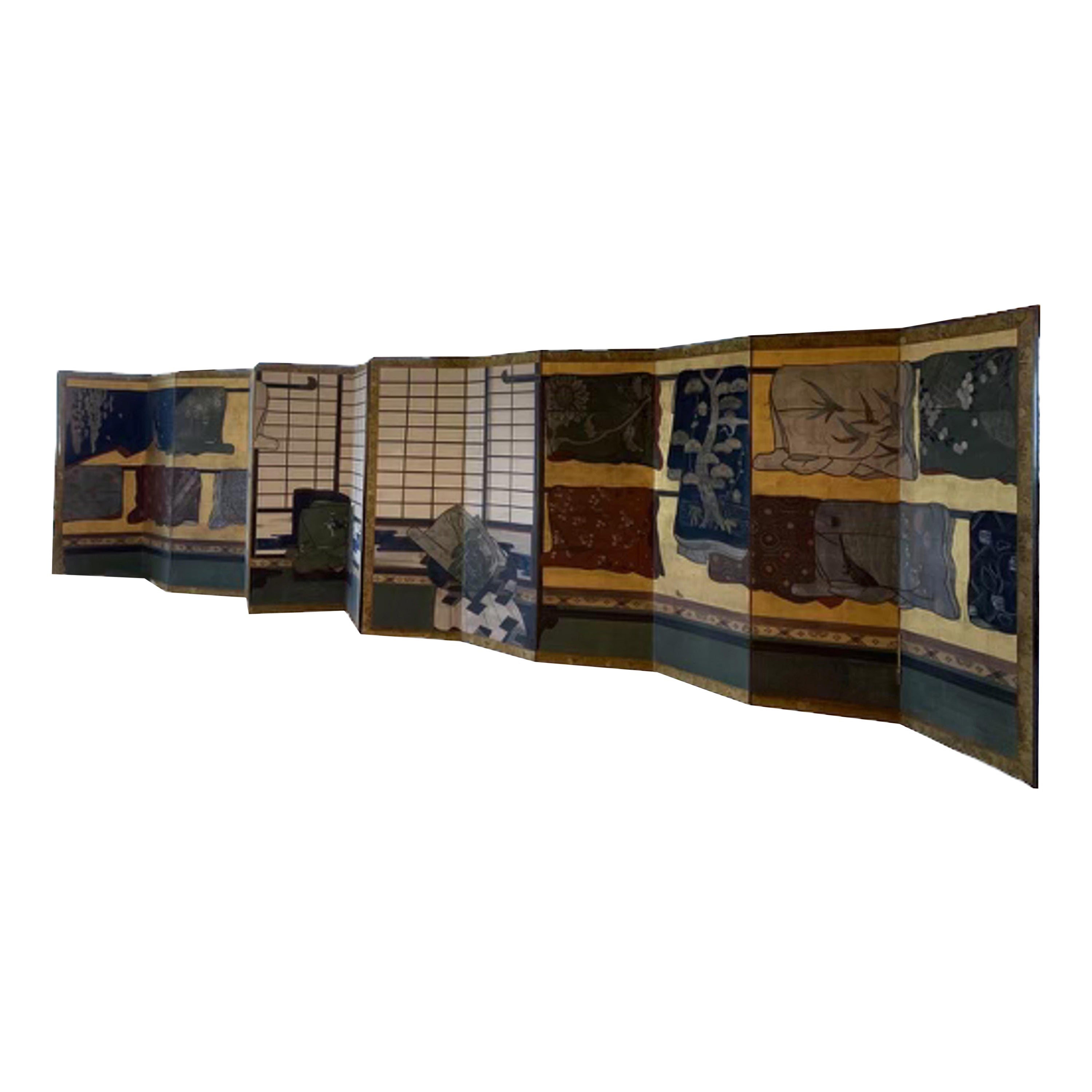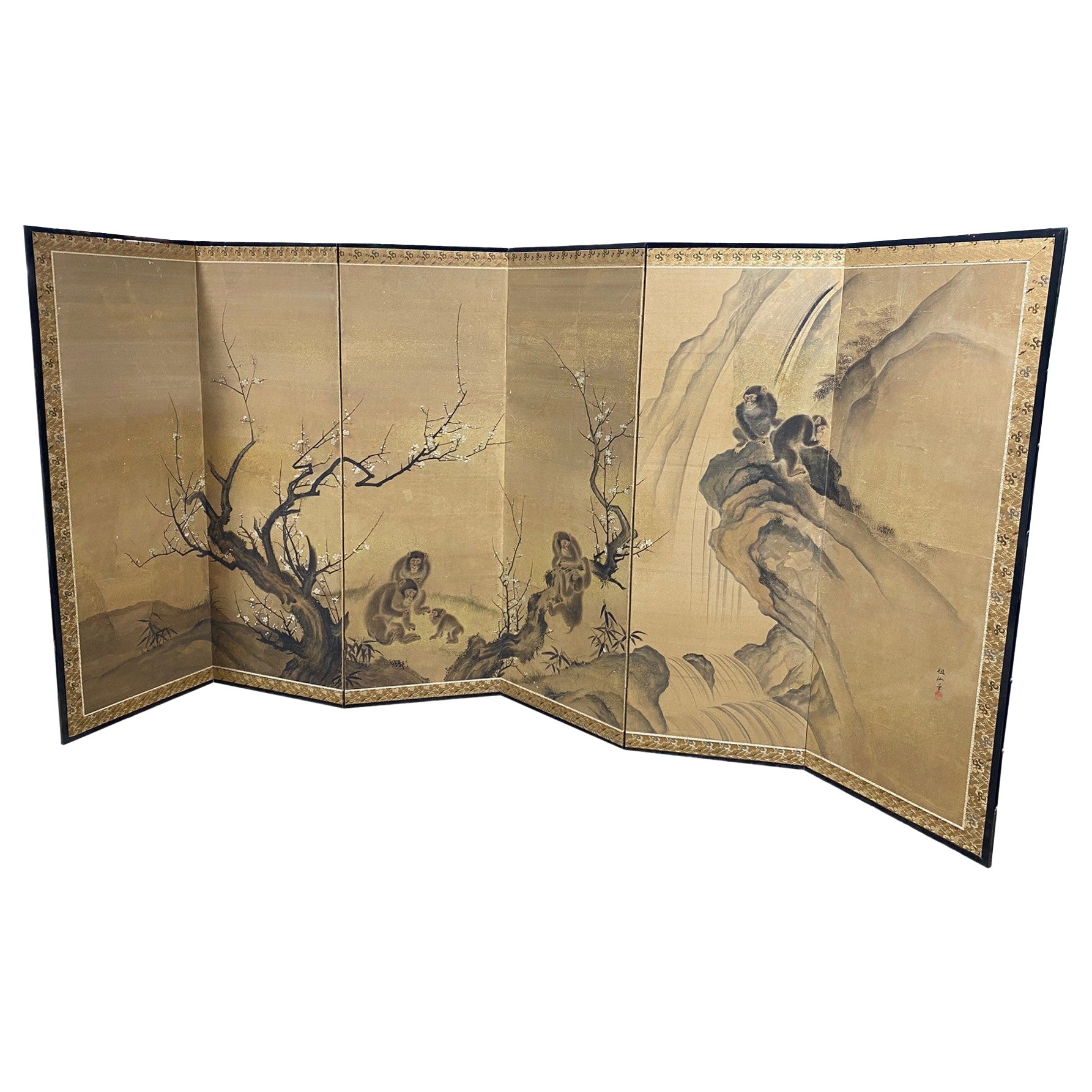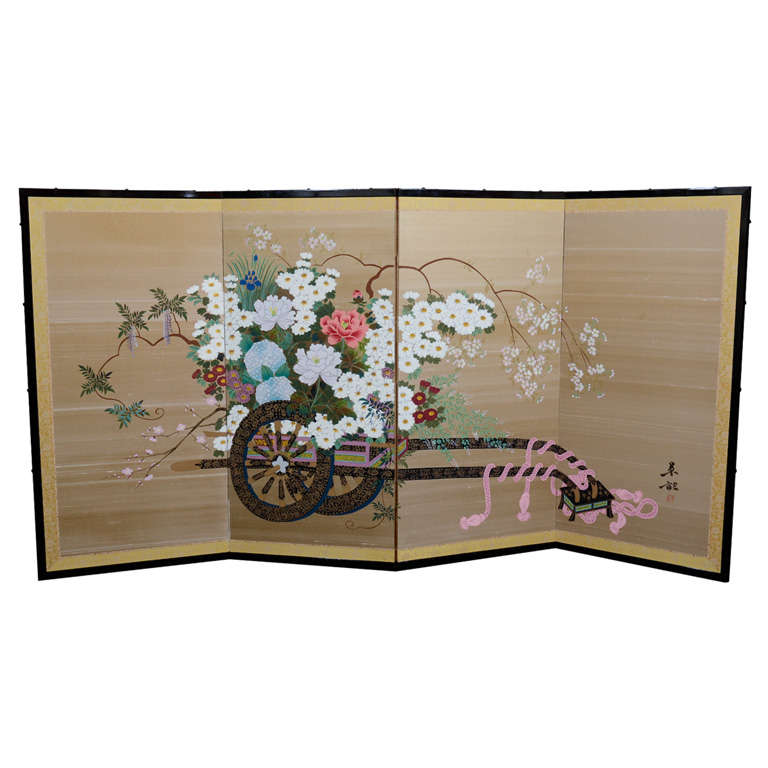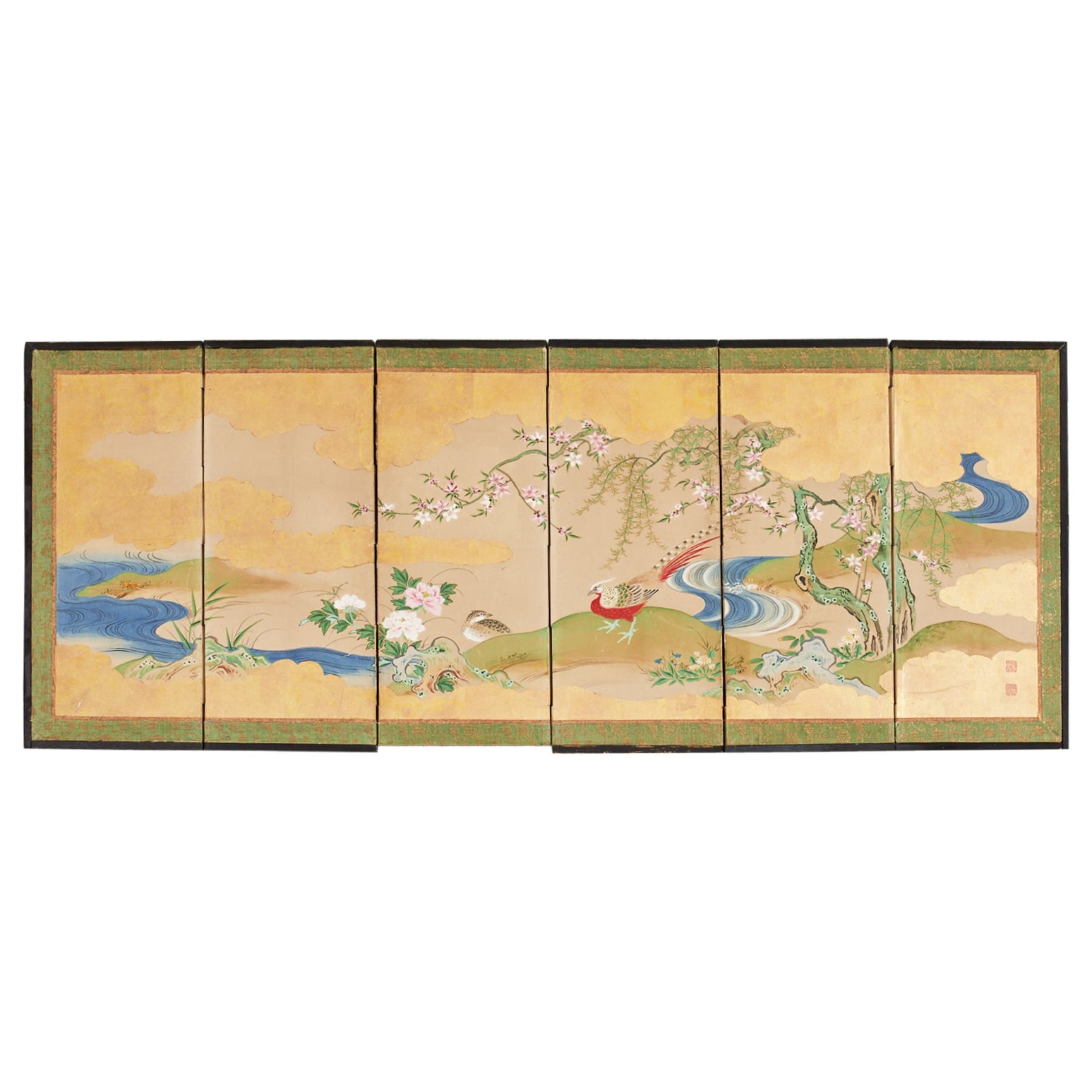Items Similar to Important Japanese six-fold screen depicting The Tale of The Genji, 17th century
Want more images or videos?
Request additional images or videos from the seller
1 of 5
Important Japanese six-fold screen depicting The Tale of The Genji, 17th century
About the Item
An important Japanese six-fold screen, depicting episodes from The Tale of The Genji
Edo period, 17th century
Ink and colour on gilded paper, H. 155 x W. 380 cm
The Tale of Genji was a popular subject for narrative illustration throughout the history of Japanese painting. Written around the year 1000 by a court lady known as Lady Murasaki, the novel traces the life and loves of the incomparable Prince Genji, and two generations of his descendants, in a highly evocative literary style.
The screen illustrates three episodes from the novel. Top left from the chapter “Channel Buoys” where Genji makes an excursion to the Naniwa area and the boat of the daughter of the monk of the Akashi sanctuary and one of Genji’s loves, enters the Bay of Naniwa. Genji writes a short note “Firm the bond that brings us to Naniwa, whose channel buoys invite me to throw myself in”. It is taken by a messenger to her. She weeps tears of joy and replies with a note “A lowly one whose place is not to demand, to what purpose, at Naniwa, should I cast myself in?”
In the middle of the screen is illustrated an episode from the chapter “A Picture Contest” where the former high priestess of Ise is about to be presented at court. The emperor sends her gifts: comb boxes, vanity chests, incense coffers and incense.
To the right is an episode where the son of Genji’s best friend, Kashiwagi and his three younger brothers play football. They all wear caps of state. The Third Princess, Genji’s very young wife, is inside the house behind the curtains but when a small cat comes running out the curtain is pulled out to reveal the Third Princess behind it. Kashiwagi has a glimpse of her and instantly falls madly in love with her.
- Dimensions:Height: 61.03 in (155 cm)Width: 149.61 in (380 cm)Depth: 1.58 in (4 cm)
- Style:Edo (Of the Period)
- Materials and Techniques:
- Place of Origin:
- Period:
- Date of Manufacture:1600-1690
- Condition:Wear consistent with age and use.
- Seller Location:Amsterdam, NL
- Reference Number:1stDibs: LU5458229666692
About the Seller
5.0
Vetted Seller
These experienced sellers undergo a comprehensive evaluation by our team of in-house experts.
Established in 1985
1stDibs seller since 2020
19 sales on 1stDibs
Typical response time: 3 hours
- ShippingRetrieving quote...Ships From: Amsterdam, Netherlands
- Return PolicyA return for this item may be initiated within 7 days of delivery.
More From This SellerView All
- Japanese Screen Depicting USA Commodore Perry’s Flagship the USS MississipiLocated in Amsterdam, NLA rare and fine Japanese six-fold gold-leaf screen with the depiction of Commodore Matthew Perry’s flagship the USS Mississippi Early Bakumatsu period (1853-1867) Measures: H. 61 x W. 183 cm Provenance: Private collection, USA On 8 July 1853 Commodore Matthew Perry with his paddle-wheel warships USS Mississippi and Susquehanna, and two sloops, with a total of 65 guns and little less than 1000 man, for the first time arrived in the harbour of Shimoda, in the bay of Edo, in his own words, “to open doors of commerce, and spread civilization to a backward people, and also to spread the Gospel of God to the heathen.” In Japanese parlance, the American ships quickly became known as “black ships,” depicted as demonic monsters. For the Japanese, these huge coal-burning ships...Category
Antique Late 19th Century Japanese Paintings and Screens
MaterialsPaint, Paper
- Japanese Painting Depicting Commodore Perry’s Ship with Buddhist Monks AboardLocated in Amsterdam, NLA Japanese painting depicting Commodore Matthew Perry’s flagship USS Mississippi bringing the coffin with the remains of US marine private Robert Williams who died while serving on t...Category
Antique Mid-19th Century Japanese Edo Paintings and Screens
MaterialsPaint, Paper
- 17th Century Japanese Export Lacquer Cabinet with Depiction the Dutch TradepostLocated in Amsterdam, NLA highly important Japanese export lacquer cabinet with depiction of the Dutch East India Company tradepost Deshima and the annual Dutch delegation on its way to the Shogun in Edo Edo period, circa 1660-1680 H. 88 x W. 100.5 x D. 54 cm This cabinet includes a later European japanned stand, but also a modern powder-coated steel frame. The latter can be designed and added to your specific needs. The sides and front of the rectangular two-door cabinet are embellished in gold and silver hiramaki-e and takamaki-e on a black roiro lacquer ground with a continuous design. The two doors depict a long procession of numerous figures travelling on foot and horseback along buildings and a pagoda into a mountainous landscape. This is the annual court journey, Hofreis, of the Dutch from Nagasaki to the Shogun’s court in Edo. Three horseback riders are dressed as Dutch merchants and a fourth figure, probably het Opperhoofd, is seen inside a palanquin, norimon. Just about to cross the bridge, two men are carrying a cabinet like the present one. Many Japanese figures on either side of the procession are engaged in various activities; some play musical instruments on board of small boats, others are fishing; figures inside buildings are depicted playing go, and farmers are tending to their rice paddocks. The upper part of the right door shows a large mansion, probably the local daimyo’s castle, with men kneeling before a man in the central courtyard. The court journey fits in with the foreign policy of the shogunate which accorded a role to the VOC alongside China, Korea, and the Ryukyu Islands who also had to pay tribute. However, the VOC employees were traders, having low status in Japan’s social hierarchy, and they were received with less deference than were the state embassies from Korea and the Ryukyu Islands. Nevertheless, the contacts with the Dutch were a welcome source of information to the Shogun about Europe and European science and technology. The left side of the cabinet depicts, in mirror image, a rare view of the artificial fan-shaped Deshima Island, the trading post for the Dutch in Japan. The island, where the Dutch flag flies, is surrounded by small Japanese boats and an anchored three-masted fluyt (cargo ship), flying Dutch flags, with on the stern the VOC monogram. On the bottom right a busy street of Nagasaki is shown, bordered by shops and leading up to the stone bridge. On the island the trees are beautifully painted, two cows can be seen, and the flagpole, all in very fine detail. Dutchmen and enslaved Malay are visible outside the buildings and two Japanese figures, probably guards, sit in a small hut in the centre. A maximum of fifteen to twenty Dutchmen lived on the island at any time and soldiers or women were not allowed. Restrictions on Deshima were tight, and the merchants were only allowed to leave the island by special permission. The Opperhoofd had to be replaced every year, and each new Opperhoofd had to make a court journey to pay tribute, present gifts, and to obtain permission to Margaret Barclay eep on trading. In the distance, many birds fly above the hills and a four-story pagoda can be seen. The right side of the cabinet is painted with other horse riders and their retinue journeying through mountains. The pair of doors to the front open to reveal ten rectangular drawers. The drawers are decorated with scenes of birds in flight and landscapes with trees and plants. The reverse of the left door with two thatched buildings, one with a ladder, underneath a camelia tree with large blooms; the right door with a three-story pagoda nestled among trees and both doors with a flying phoenix, ho-oo bird. The cabinet, with elaborately engraved gilt copper mounts, hinges, lock plates and brass handles, is raised on an 18th-century English japanned wood stand. A pair of large cabinets...Category
Antique 17th Century Japanese Edo Lacquer
MaterialsCopper, Gold
- Dutch Colonial Japanese Scroll Painting of Chief Merchant DoeffLocated in Amsterdam, NLNagasaki School (EARLY 19TH CENTURY) Opperhoofd Hendrik Doeff with Javanese servant Kakemono, watercolor on paper, mounted on silk and textile covered paper scroll, not signed....Category
Antique Early 19th Century Japanese Edo Paintings and Screens
MaterialsSilk, Paper
- Japanese Scroll Painting of Diplomat Takeaki Enomoto, Meiji, Late 19th CenturyLocated in Amsterdam, NLAnonymous Japanese painter (MEIJI PERIOD, LATE 19TH CENTURY) Portrait of Takeaki Enomoto (1836-1908) Ink, color and go fun on silk, framed. Painting: 79.5 x 50 cm With fram...Category
Antique Late 19th Century Japanese Meiji Paintings and Screens
MaterialsSilk, Paper
- Chinese Export Trade Painting Depicting ‘the Tea Shop', Chinoiserie ChiqueLocated in Amsterdam, NLA refined Chinese export painting depicting ‘The Tea shop’ Canton, early 19th century Ink and watercolour on silk, H. 63.5 x W. 52.3 cm Framed in giltwood frame. ?The paintin...Category
Antique Early 19th Century Chinese Chinese Export Paintings and Screens
MaterialsSilk
You May Also Like
- 17th Century 'Late 1600s', Japanese Edo Period 12-Panel Folding Screen PaintedLocated in North Miami, FLA pair of 17th Century (Late 1600s) Japanese Edo screens made of 12-panels. This folding silk screen is painted on a gold leaf background. It has a...Category
Antique 17th Century Japanese Edo Paintings and Screens
MaterialsSilk, Wood, Paint, Paper
- Japanese Asian Large Six-Panel Folding Byobu Flower Cart Screen, 19th CenturyLocated in Studio City, CAA gorgeous six-panel Japanese Byobu folding screen. Listing as Meiji period but could very possibly Edo period. Decorated with peonies, irises and...Category
Antique 19th Century Japanese Meiji Paintings and Screens
MaterialsGold Leaf
- Japanese Asian Large Edo Six-Panel Folding Byobu Screen Landscape Monkeys TreesLocated in Studio City, CAAn absolutely gorgeous, wonderfully composed six-panel Japanese byobu folding screen / room divider depicting a family of playful monkeys among the blooming trees and mountainous lan...Category
Antique Early 19th Century Japanese Edo Paintings and Screens
MaterialsGold Leaf
- Antique Japanese Six-Panel Screen by Kano ChikanobuLocated in Prahran, VictoriaLate 17th century Kano school peony landscape screens. One of a pair of screens signed: Hogan Josen Fujiwara Chikanobu Hitsu - Kano Chikanobu (Shushin) ...Category
Antique Early 18th Century Japanese Edo Paintings and Screens
MaterialsGold Leaf
- Vintage Japanese "Flower Cart" Folding ScreenLocated in New York, NYA traditional style Japanese four panel folding screen depicting a flower cart full of red and white flowers. 10198Category
20th Century Japanese Screens and Room Dividers
- Japanese Edo Six Panel Table Screen After Maruyama OkyoLocated in Rio Vista, CAFantastic diminutive Japanese Edo period table top screen depicting a lively water landscape with flora and fauna. The screen is beautifully painted o...Category
Antique 19th Century Japanese Edo Paintings and Screens
MaterialsBrass, Gold Leaf
Recently Viewed
View AllMore Ways To Browse
Folded Paper Furniture
Small Screen
Important Japanese
Small Cat
Gilt Screen
Brown Folding Screen
Painted Folding Screen
Six Fold
Folding Picture
Japanese Emperor
Emperor Japan
Antique Folding Screen
Antique Folding Screens
Antique Folding Screen Antiques
Folding Screen Antique
Folding Screen Antique Furniture
Antique Paper Paint Color
Japanese Small House





